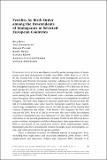Fertility by birth order among the descendants of immigrants in selected European countries
Abstract
This study investigates the childbearing patterns of the descendants of immigrants in six European countries, with a focus on women whose parents arrived in Europe from high-fertility countries. While the fertility levels of immigrants to Europe have been examined in the recent literature, the childbearing patterns among their descendants have received little attention. Using longitudinal data from six European countries and applying Poisson regression models, the study shows that many descendants of immigrants exhibit first birth levels that are similar to the native population in their respective countries; however, first birth levels are slightly elevated among women of Pakistani and Bangladeshi origin in the UK and for those of Turkish descent in France and Belgium. Transition rates to a second child vary less across ethnic groups; only women of Pakistani and Bangladeshi origin in the UK exhibit elevated second birth levels. Most women with immigrant family background in the UK, France and Belgium show significantly higher third birth levels than natives in those countries. The inclusion of women’s level of education in the analysis has little effect on fertility differences across the ethnic groups. Overall, the childbearing behaviour of the second generation falls in between the fertility pathways experienced by their parents’ generation and the respective native populations. The analysis supports the idea that both the mainstream society and the minority subculture shape the childbearing patterns of the descendants of immigrants in Europe. Fertility levels of the descendants of immigrants from high-fertility countries are expected to further decline in the third generation, but a significant intra-group heterogeneity is likely to persist.
Citation
Kulu , H , Hannemann , T , Pailhé , A , Neels , K , Krapf , S , González-Ferrer , A & Andersson , G 2017 , ' Fertility by birth order among the descendants of immigrants in selected European countries ' , Population and Development Review , vol. 43 , no. 1 , pp. 31-60 . https://doi.org/10.1111/padr.12037
Publication
Population and Development Review
Status
Peer reviewed
ISSN
0098-7921Type
Journal article
Description
The research leading to these results has received funding from the European Union's Seventh Framework Programme (FP7/2007-2013) under grant agreement no. 320116 for the research project FamiliesAndSocieties.Collections
Items in the St Andrews Research Repository are protected by copyright, with all rights reserved, unless otherwise indicated.

